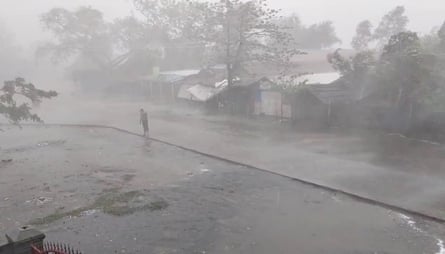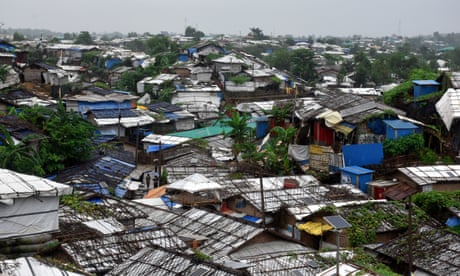People living in Sittwe, the capital of Rakhine state, said they estimated that about 90% of homes of Rohingya people had been destroyed and more than 100 people killed when winds of more than 150 miles an hour hit the region. However, the refugee agency UNHCR said the Myanmar government had not yet granted access to the camps in Sittwe, home to about 100,000 people. "As yet, UNHCR has not been granted access to carry out needs assessments."
Bright Islam, a 28-year-old Rohingya activist, said: "The cyclone destroyed everything we had. We have nothing to eat, and people have to sleep on the road. Injured people don't have access to medical treatment."
It really is a nightmare scenario for this cyclone to hit areas with such deep pre-existing needsRamanathan Balakrishnan, UN humanitarian coordinator
He said he witnessed people drown in the flood water in Sittwe, "mostly children and older people", and counted about 110 dead bodies when the waters cleared. "I cried because I was afraid, I could also be dead," he said.
Habibullah, who only wanted to be known by one name, said his 55-year-old aunt died in the storm because she was too scared to leave her home in Dar Paing camp in Sittwe. "She didn't expect that it would be that bad," he said.
He said he had to leave her in her house while he helped others. After the cyclone, he found her body. "I am very sorry to leave her there. But I had no other choice. If we had early warning and precaution in time, she would still be alive."
Cyclone Mocha hit Myanmar on its journey across the Bay of Bengal. Sittwe was the worst affected area, but the category 5 storm also damaged towns further east in Chin, Sagaing and Magway regions.
The UN said on Thursday that 17 townships in Rakhine and four in Chin had been declared natural-disaster-affected areas by the government. Images on social media show trees, buildings, and electricity poles toppled, and debris piled on the ground. The UN said health supplies and water purification tablets for 200,000 people have been sent to Sittwe.

On Tuesday, Ramanathan Balakrishnan, the UN humanitarian coordinator for Myanmar, said 5.4 million people were thought to live in the cyclone's path. "Of these, we consider 3.1 million people to be most vulnerable to cyclone impacts by taking together indicators of shelter quality, food insecurity and poor coping capacity.
"It really is a nightmare scenario for this cyclone to hit areas with such deep pre-existing needs," Balakrishnan said.
The Rohingya live in internal displacement camps after being forced from their homes in Myanmar by numerous military attacks since the 1970s. A military "clearance" in 2017 pushed a million Rohingya to seek refuge in Bangladesh.
Reuben Lim, the chief communications officer for UNHCR Myanmar, confirmed that "deaths by drowning have been reported in displacement camps with many others missing".
Ro Nay San Lwin, a Rohingya activist in Europe, said he expected high casualties. He said early warning announcements of the cyclone made by the military through loudspeakers in the camps were "just for show" as no logistical support, shelters or transport, were provided and Rohingya were not allowed to leave the camps.
"People lost their lives because they had no freedom of movement. The junta has been committing serious international crimes against the Rohingya for many decades. Their aim is to eliminate the entire population from the country."

Islam said they were "living in hell". "We got more affected by the cyclone because our camp is close to the sea and our movement is under control," he said. "If we could stay in our original homes, it wouldn't have been that bad."
In Bangladesh, about 60,000 people were displaced and 30,000 homes damaged or destroyed in Cox's Bazar district, where more than 1 million Rohingya live in refugee camps.
Rohingya Refugee Response, which coordinates humanitarian support for more than 900,000 refugees in Bangladesh, said 5,800 shelters were damaged and 400 destroyed. Health and education centres and water points were damaged by landslides. UNHCR said it has been providing emergency shelter and other services in Bangladesh.
The worst conditions were on the southern-most tip of mainland Bangladesh and in the Nayapara refugee camp, where refugees who lost their homes to a fire two years ago again saw homes damaged.
"Our block was already burned down and so the shelters were only light plastic and bamboo," said Amir Hossain, whose shelter was damaged. "People were worried before the cyclone hit the camp. As soon as the strong winds started, most of the tarpaulin roofs were blown away and only the frames of the homes were left.
"People are struggling to rebuild again, we have not got the materials to rebuild the shelters. Some people are living in community centres and schools for now," he said.
Amid the destruction, seven babies were born in one of the refugee camps further north, on Sunday, according to the NGO Friendship.




No comments:
Post a Comment
Your comment will be approved soon and your email will not be published.. thanks..